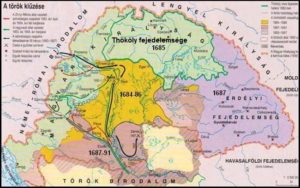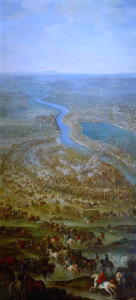11 September 1697 The Battle of Zenta
Prince Eugene de Savoy’s stunning victory over the army of the Sultan

By 1697, the Imperial troops had reconquered most of Hungary’s regions, and only the southern lands remained under Ottoman authority where they held castles and forts. Then, Sultan Mustapha II set out again to Hungary, leading his army in person, hoping that his presence would gain success to the Ottoman arms. He thought that the recent anti-Habsburg uprising in Hegyalja in north Hungary would divert the attention of the Imperials who would have to send troops to the north, thus weakening the southern Christian army.

He was right because the Habsburg military decision-makers could not afford to endure a movement in his hinterland which was tending to take the Turks’ side. The rebelling Hungarian peasants at Hegyalja were recruited by telling them that Thököly Imre would come and join them. We know, that Thököly Imre had been alienated by the Habsburgs and without him, the siege of Vienna in 1683 would never have happened. He had made enough trouble to the Emperor already. It was the reason why the Imperials did send several thousand soldiers from the southern regions to put down the uprising. They quickly succeeded in doing so but Sultan Mustapha have already arrived in Hungary, and Thököly Imre was in his camp. He wanted to become the prince of Upper Hungary.

The Ottomans could not decide where to attack and their army was aimlessly marching to and fro in the Temesköz region. The Temesköz is a great plain, bordered by the Maros, Tisza, and the Danube rivers in the Bánság (Banate) area, its main river is the Temes river that crosses it. The sultan was hesitating to attack Transylvania or besiege Pétervárad castle.

At last, the choice fell on Transylvania and they moved to the north, following the Tisza river. They crossed the river several times, and they wanted to cross it again on 11 September because they desired some distance between them and the Imperial army. In the morning, the Imperials could take Pasha Dzsáfer into captivity, he led an Ottoman reconnaissance unit. He was personally interrogated by Prince Eugene of Savoy, the chief commander of the Imperial army. Dzsáfer told him everything he wanted to know.

According to him, half of the Sultan’s army had already crossed the river but their rear guard was still on the other side of the Tisza river, behind double trenches. Yet, they could not finish the outer trench, and a large section was still missing. The Ottoman cavalry stood between the two trenches while the infantry was deployed behind the second trench. Recognizing the opportunity, Prince Eugene ordered an immediate attack.

The Imperial cavalry broke through the gap of the outer trench, and the artillery did a good job of covering their move. The Imperials had 60,000 men while the enemy had 70-80,000 soldiers but only half of them stayed on this bank of the river. The Christian cannons began to bombard the boat bridge that connected the two parts of the Ottoman army at 5 p.m. There was great confusion on the makeshift bridge because some Turkish units tried to cross the river while the Sultan sent reinforcement from the opposite side.
The Ottomans who got stuck in the trenches tried to sally twice but the Imperials repelled them. General Guido Starhemberg led the left wing, he attacked the enemy along the Tisza river and managed to get behind the Turks who were fighting in the trenches. At the same time, the infantry was assaulting the Ottomans from the other side. The Imperial cavalry could reach the boat bridge and they were able to cut the Ottomans’ withdrawal. The Janissaries tried to escape by swimming but the musketmen shot them from the opposite bank.

Grand Vizier Elmász Mehmed fell, and several pashas were killed, too. Thököly also got stuck on the right bank and he hid among the dead. He waited for the night when he could swim to the other bank and flee. The Ottomans lost 25,000 men, and the Sultan fled, leaving behind all his valuables and heavy artillery. The Imperials had 500 dead and 1,500 wounded men. Sultan Mehmed II lost Hungary for good, and the disastrous defeat forced the Sublime Porte to sign a peace. According to the Treaty of Karlóca, the Ottoman Empire had to leave Hungary, except for the Temesköz Region.

Source: Szibler Gábor
You can watch a video of the Battle of Zenta here:
https://www.hungarianottomanwars.com/videos/the-battle-of-zenta-1697/
Dear Readers, I can only make this content available through small donations or by selling my books or T-shirts.
If you like my writings, please feel free to support me with a coffee here:
You can check out my books on Amazon or Draft2Digital, they are available in hardcover, paperback, or ebook:
https://www.amazon.com/dp/198020490X
or at https://books2read.com/b/boYd81


My work can also be followed and supported on Patreon: Become a Patron!http://Become a Patron!


https://hungarianottomanwars.myspreadshop.com/

https://hungarianottomanwars.myspreadshop.com/all



